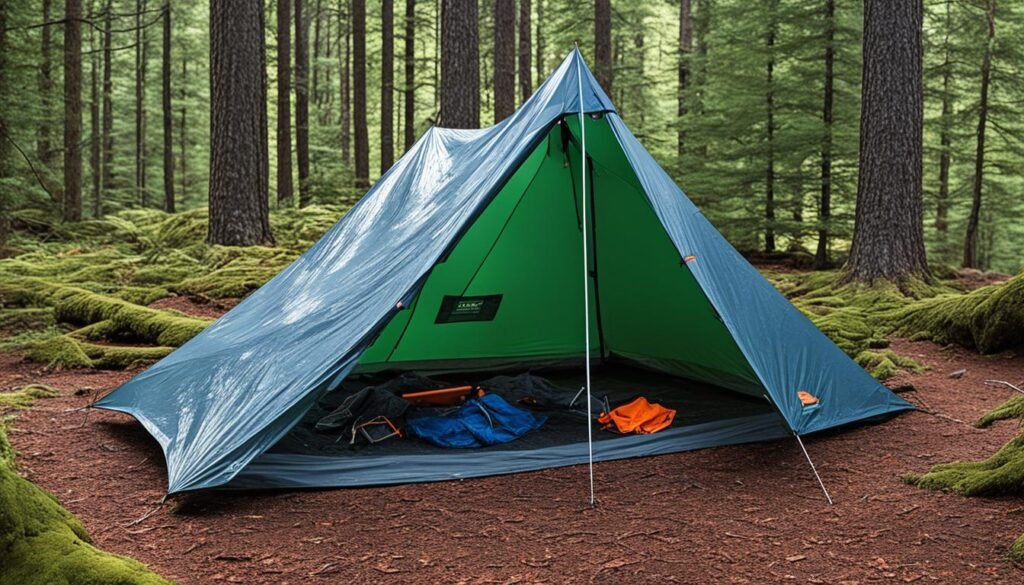Are you ready to elevate your camping experience? Installing a rooftop tent on your car can provide a comfortable and elevated camping space, allowing you to sleep above the ground and enjoy breathtaking views. Whether you’re planning a weekend getaway or a cross-country adventure, here is a detailed guide with step-by-step instructions to help you successfully install a rooftop tent on your car.
Key Takeaways:
- Installing a rooftop tent can enhance your camping experience by providing a comfortable and elevated sleeping space.
- Consider the weight capacity of your vehicle, roof rack, and cross bars to ensure they can support the weight of the rooftop tent.
- There are two common mounting options: roof racks and cross bars. Choose the option that is best suited for your vehicle and needs.
- Proper preparation, assembly, and attachment of the rooftop tent are crucial for a secure and stable installation.
- Follow safety precautions and maintenance tips to ensure a safe and enjoyable camping adventure.
Types of Mounting Options for Rooftop Tents
When it comes to mounting a rooftop tent on your vehicle, there are two common options to choose from: roof racks and cross bars. Each option has its own advantages and considerations, so let’s take a closer look to help you determine which one is best for your needs.
Roof Racks
Roof racks are a popular choice for mounting rooftop tents, especially for cars, SUVs, and trucks. These racks provide a sturdy and secure platform on the roof of your vehicle, allowing for easy installation and removing the need for additional accessories. Roof racks are designed specifically for the make and model of your vehicle, ensuring a precise fit and compatibility.
Pros:
- Provides a dedicated mounting solution designed for your vehicle
- Offers excellent stability and weight distribution
- Allows for the attachment of other accessories, such as bike racks or cargo carriers
Cons:
- May require professional installation or specific tools
- Can be more expensive compared to cross bars
- May have weight limitations based on the roof rack’s capacity
Cross Bars
Cross bars, on the other hand, provide a more versatile mounting option for rooftop tents. They are compatible with a wider range of vehicles and can be easily adjusted to fit different roof widths and designs. Cross bars are typically sold separately and can be attached to existing roof rails or mounted directly to the roof itself.
Pros:
- Offers flexibility to fit various vehicles and roof designs
- Typically more affordable compared to roof racks
- Easier to install and remove, especially for occasional use
Cons:
- May require additional accessories or adapters for proper mounting
- Can have lower weight capacity compared to roof racks
- Might affect the overall vehicle height and clearance
Ultimately, the choice between roof racks and cross bars for mounting your rooftop tent depends on your specific vehicle and needs. Consider factors such as compatibility, ease of installation, weight capacity, and budget. If you’re unsure, consult with a professional or seek advice from experts to ensure a safe and reliable mounting solution for your rooftop tent.
Understanding Weight Capacity for Rooftop Tents
Before installing a rooftop tent on your vehicle, it’s crucial to have a clear understanding of the weight capacity. The weight capacity refers to the maximum weight the rooftop tent, vehicle, roof rack, and cross bars can safely support. By considering the weight limits, you can ensure a secure and stable setup for your camping adventures.
There are two types of weight capacity that you need to be aware of: dynamic weight capacity and static weight capacity.
Dynamic Weight Capacity vs Static Weight Capacity
The dynamic weight capacity is the weight limit while your vehicle is in motion on the road. It takes into account factors such as acceleration, braking, and cornering. This capacity is crucial to ensure the safety and stability of your vehicle while driving with a rooftop tent.
The static weight capacity, on the other hand, refers to the weight limit while your vehicle is stationary. It is the maximum weight that your vehicle, roof rack, and cross bars can support without any movement. This capacity is important to ensure the structural integrity of your rooftop tent setup when you’re parked at a campsite.
When determining the weight capacity for your rooftop tent installation, consider not only the weight of the tent itself but also any additional gear or equipment that you plan to carry on the roof. This can include items such as camping gear, coolers, or kayaks. Make sure to check the specifications provided by the manufacturer to verify the weight limits and compatibility of your rooftop tent, vehicle, roof rack, and cross bars.
Mounting a Rooftop Tent on Cross Bars
When it comes to installing a rooftop tent on your vehicle, mounting it on cross bars is a cost-effective and straightforward solution. Cross bars offer a versatile and sturdy platform for securing your rooftop tent, allowing you to enjoy the outdoors in comfort and style.
There are various mounting options available for cross bars, depending on the make and model of your vehicle. To determine the compatibility and specific mounting method for your vehicle, it is recommended to contact your dealer or use vehicle fit tools provided by reputable manufacturers.
Proper installation and secure attachment of the rooftop tent to the cross bars are essential for a safe and enjoyable camping experience. Follow the manufacturer’s instructions carefully and ensure that all components are tightly secured. Regularly inspect the mounting system to detect any signs of wear or loosening.
By choosing cross bars as your mounting option, you’ll benefit from their versatility and ability to fit a wide range of vehicles. Whether you own an SUV, a sedan, or a hatchback, cross bars can provide a reliable foundation for your rooftop tent.
Remember to consider the weight capacity of your cross bars and rooftop tent to ensure that they can safely support the load. The dynamic weight capacity, which refers to the weight limit while the vehicle is in motion, and the static weight capacity, which refers to the weight limit while the vehicle is stationary, should both be taken into account.
To give you a visual representation of the different mounting options for cross bars, take a look at the table below:
| Mounting Option | Description |
|---|---|
| Clamp Mounts | Secure the cross bars to the side rails or existing roof rack using clamp-style mounts. |
| T-Track Mounts | Utilize the T-slot channel on top of the cross bars to fasten the rooftop tent with specialized hardware. |
| Universal Mounts | Offer a versatile solution by providing adjustable and adaptable mounting options for various cross bar sizes and shapes. |
Choose the mounting option that best suits your vehicle and preferences, ensuring a secure and stable installation. With a properly mounted rooftop tent, you’ll be ready to embark on unforgettable camping adventures.
Choosing a Roof Rack for a Rooftop Tent
A roof rack is an essential component for securely mounting a rooftop tent on your vehicle. When selecting a roof rack, there are several factors to consider, including compatibility, weight capacity, and design. Choosing the right roof rack will provide a sturdy and reliable platform for your rooftop tent.
First, ensure that the roof rack you choose is compatible with your vehicle’s make and model. Different vehicles require different roof rack designs and attachment methods. Refer to the manufacturer’s guidelines or consult with a trusted dealership to find a roof rack that is suitable for your specific vehicle.
Weight capacity is another crucial consideration. Rooftop tents can be heavy, so it’s essential to choose a roof rack that can safely support the weight. The weight capacity of a roof rack is typically specified by the manufacturer. Be sure to check this information and ensure that it matches or exceeds the weight of your rooftop tent.
When it comes to design, there are various options available, including flat racks, platform racks, and basket racks. Consider your specific needs and preferences when choosing a design. Flat racks provide a sleek and low-profile look, while platform racks offer a larger surface area for additional gear. Basket racks are ideal for carrying bulkier items like coolers or gas cans.
Some popular brands for roof racks that are known for their durability and quality include Prinsu, Front Runner, Rhino Rack, and Gobi. These brands offer a range of roof rack options designed to fit different vehicle models and provide reliable performance.
Once you have selected a roof rack, it’s crucial to follow the manufacturer’s installation instructions carefully. Improper installation can compromise the stability and safety of your rooftop tent setup. If you’re not confident in your ability to install the roof rack yourself, consider seeking professional assistance from a reputable auto shop or roof rack installation service.
Installing a Rooftop Tent on a Truck Bed Rack
If you own a truck, you have the option to install a rooftop tent on a bed rack. This provides a convenient and elevated camping space, allowing you to enjoy the great outdoors comfortably. There are two popular types of truck bed racks for rooftop tent installation: cab-height bed racks and low bed racks.
Cab-Height Bed Rack
A cab-height bed rack is an excellent choice for trucks with short beds. The bed rack sits at the same height as the truck’s cabin, allowing the rooftop tent to extend over the cab. This design provides maximum vertical storage space for your camping gear and equipment. With a cab-height bed rack, you can easily access your belongings without having to detach the rooftop tent.
Low Bed Rack
On the other hand, low bed racks are perfect for compact rooftop tents. These bed racks sit lower to the truck bed, resulting in better off-road handling and reduced wind drag. A low bed rack offers a sleek and streamlined profile, making it an ideal choice for those who prioritize aerodynamics and maneuverability while driving.
Popular brands known for their high-quality truck bed racks include Leitner Designs, upTop Overland, and Yakima. These brands offer a variety of bed racks with different features and designs to suit your specific needs and preferences.
When installing a rooftop tent on a truck bed rack, it’s crucial to follow the manufacturer’s instructions and ensure a secure and stable attachment. This will provide a safe and enjoyable camping experience while maximizing the use of your truck’s space. Before making a final decision, consider factors such as your truck’s bed length, the size of the rooftop tent, and your camping requirements.
Preparation for Installing a Rooftop Tent
Before you begin installing a rooftop tent on your vehicle, it’s important to properly prepare your vehicle for the installation process. This will ensure a smooth and successful installation, as well as protect your vehicle from any potential damage. There are two key steps that you should follow: cleaning your vehicle and assessing its suspension capabilities.
Cleaning Your Vehicle
Prior to installing the rooftop tent, take the time to thoroughly clean your vehicle, paying special attention to the roof area. Remove any dirt, debris, or grime that may be present. Cleaning your vehicle not only helps ensure a clean and secure attachment of the rooftop tent, but it also prevents any abrasive materials from scratching the surface or compromising the installation process.
Start by washing your vehicle, using a mild detergent and a soft sponge or cloth. Pay attention to the roof area, making sure to remove any stubborn dirt or stains. Once the vehicle is clean, dry it thoroughly to prevent water spots or streaks.

Assessing Suspension Capabilities
Before proceeding with the installation, it’s important to assess your vehicle’s suspension capabilities. Rooftop tents can add significant weight to your vehicle, and if your suspension is not designed to bear heavier loads, it may affect the overall performance and safety of your vehicle.
If you have any concerns about your vehicle’s suspension, consider consulting with a professional or your vehicle manufacturer. They can provide guidance on whether any modifications or repairs are necessary to ensure your vehicle is capable of safely supporting the added weight of a rooftop tent.
By taking the time to properly prepare your vehicle for the installation of a rooftop tent, you can ensure a successful and hassle-free process. Clean your vehicle thoroughly to create a clean and secure attachment surface, and assess your vehicle’s suspension capabilities to guarantee optimal safety and performance.
Assembling the Rooftop Tent
When it comes to assembling your rooftop tent, it’s essential to follow the provided instructions carefully. Here are the key steps to ensure a successful assembly:
-
Unbox the rooftop tent and lay out all the components in a clear area. This will help you visualize the setup process and ensure that all parts are accounted for.
-
Inspect the tent for any defects, damage, or missing parts. Check the fabric, zippers, poles, and other components thoroughly. Taking the time to do this before installation will save you from potential frustrations later.
-
Familiarize yourself with the assembly process while the tent is still at ground level. This allows you to become comfortable with the setup and helps prevent any unnecessary struggles when installing the tent on your car’s roof.
-
Follow the step-by-step instructions provided with the tent. Each tent model may have specific assembly requirements, so it’s crucial to adhere to the manufacturer’s guidelines.
-
Pay attention to the sequence of steps and ensure that all connections, attachments, and fastenings are secure and properly tightened.
-
Once the rooftop tent is fully assembled, double-check that everything is in its correct position and that any adjustable components are set to your desired preferences.
By following these assembly instructions and checking for defects or missing parts, you’ll be able to assemble your rooftop tent efficiently and with confidence.
Here is an image of a rooftop tent being assembled:
| Pros | Cons |
|---|---|
| Easy-to-follow assembly instructions | Possible defects or missing parts |
| Opportunity to familiarize yourself with the tent’s setup process | Potential struggles during installation on the roof |
| Secure and properly tightened connections | Time-consuming process |
Attaching the Rooftop Tent to the Roof Rack/Cross Bars
To securely attach your rooftop tent to the roof rack or cross bars, follow these step-by-step instructions.
- Position the tent as closely as possible to the desired mounting location, ensuring that it does not impede doors, windows, handles, or other obstacles.
- Use the provided hardware, including mounting brackets, bolts, washers, and nuts, to attach the tent’s base to the roof rack or cross bars. Make sure to align the brackets correctly and tighten all fasteners.
- Double-check the alignment and tightness of all fasteners to ensure a secure and stable installation.
Attaching the rooftop tent to the roof rack or cross bars is a crucial step in the installation process. By following these instructions and using the provided hardware, you’ll ensure the tent is securely attached, minimizing the risk of accidents or damage during your camping trips.

Centering and Securing the Rooftop Tent
Once the rooftop tent is attached to the roof rack or cross bars, it’s crucial to ensure that it is centered properly. By centering the tent, you can achieve an even weight distribution across the roof, enhancing stability while driving and providing a balanced camping experience. To center the rooftop tent:
- Measure the distance between the left and right edges of the roof rack or cross bars.
- Measure the distance between the left and right edges of the rooftop tent’s base.
- Adjust the position of the tent to align its base with the center of the roof rack or cross bars.
By following these steps, you can ensure that the weight of the rooftop tent is evenly distributed, reducing the risk of instability or handling issues while driving.
Once the rooftop tent is centered, it’s important to secure it properly to the roof rack or cross bars. This ensures that the tent remains in place, even during rough terrain or windy conditions. To secure the rooftop tent:
- Double-check all fasteners, including bolts, washers, and nuts, to ensure they are tightened securely.
- Inspect the mounting brackets and hardware for any signs of looseness or wear.
- Tighten any loose fasteners, replacing them if necessary.
Confirm that the ladder is properly aligned and securely attached to the designated mounting points on the tent. This will ensure safe and easy access to and from the rooftop tent.
By centering and securing the rooftop tent, you can enjoy a comfortable and stable camping experience, whether you’re exploring the great outdoors or embarking on an epic road trip.
Safety Tips for Using a Rooftop Tent
Follow these safety tips to ensure a safe and enjoyable camping experience with your rooftop tent:
- Park on a flat surface before deploying the rooftop tent.
- Respect the weight limitations specified by the tent, roof rack, and ladder.
- Always maintain three points of contact when using the ladder.
- Open the vents to prevent condensation buildup inside the tent.
- Avoid using open flames inside the tent to reduce the risk of fire.
- Secure all loose items to prevent them from falling or causing accidents.
- Never drive with the rooftop tent deployed as it can affect the vehicle’s stability and increase the risk of accidents.
By following these safety precautions, you can have peace of mind and enjoy your rooftop tent camping experience to the fullest.
Maintenance and Care for Rooftop Tent
Proper maintenance and care are essential to ensure the longevity of your rooftop tent. By following these maintenance tips, you can keep your rooftop tent in excellent condition for years to come.
Cleaning
Regular cleaning is crucial to remove dirt, dust, debris, and garbage that can accumulate on your rooftop tent. Here are some cleaning tips:
- 1. Remove loose dirt: Use a soft brush or cloth to remove any loose dirt or debris from the tent fabric and surrounding surfaces.
- 2. Gentle cleaning: Mix a mild soap or detergent with water. Gently scrub the tent fabric using a sponge or soft brush. Avoid using harsh chemicals or abrasive cleaners that can damage the fabric.
- 3. Rinse thoroughly: Rinse the tent fabric with clean water to remove any soap residue. Ensure that all cleaning agents are thoroughly rinsed off before allowing the tent to dry.
- 4. Dry completely: After cleaning, allow the tent to air dry completely in a shaded area. Ensure that both the tent fabric and any other components, such as poles or ladder, are completely dry before storing them.
Storing
Proper storage is important to protect your rooftop tent from damage and to prevent mold and mildew growth. Follow these tips for storing your rooftop tent:
- 1. Clean and dry: Before storing, make sure to clean and dry the tent as mentioned above. Remove any traces of dirt or moisture to prevent mold and mildew growth during storage.
- 2. Fold carefully: Follow the manufacturer’s instructions for folding the tent to avoid any creases or damage to the fabric. Improper folding can lead to premature wear and tear.
- 3. Store in a dry location: Choose a dry, well-ventilated area to store your rooftop tent. Avoid areas that are prone to moisture, such as basements or damp garages.
Inspection and Repairs
Regularly inspect your rooftop tent for any signs of damage, such as broken zippers, tears, or bent poles. Promptly repair any issues to prevent further damage and ensure the tent’s functionality. Follow these steps:
- 1. Check zippers: Inspect all zippers for smooth operation. Lubricate them with a silicone or paraffin-based zipper lubricant to ensure they function properly.
- 2. Repair tears or holes: Use a repair kit specifically designed for tent fabrics to mend any tears or holes. Follow the manufacturer’s instructions for the repair process.
- 3. Lubricate moving parts: Lubricate the pivot points and moving parts, such as hinges and joints, with a silicone or Teflon-based lubricant to prevent rust and ensure smooth operation.
Regular maintenance and proper care will not only extend the life of your rooftop tent but also ensure that it continues to provide a comfortable and reliable camping experience. Dedicate some time to routine cleaning, thorough inspections, and necessary repairs to keep your rooftop tent in optimal condition.
| Stay Maintenance Tips | Cleaning Tips | Storage Tips |
|---|---|---|
| Regular cleaning to remove dirt and debris | Remove loose dirt before cleaning | Clean and dry the tent before storage |
| Gentle cleaning with mild soap or detergent | Gently scrub the tent fabric with a sponge or soft brush | Fold carefully as per manufacturer’s instructions |
| Thoroughly rinse off any soap residue | Rinse the tent fabric with clean water | Store in a dry, well-ventilated area |
| Air dry completely before storage | Allow the tent to air dry in a shaded area | Avoid areas prone to moisture |
| Regularly inspect for damage and repair promptly | Check zippers for smooth operation | Repair any tears or holes |
| Lubricate moving parts for smooth operation | Use a repair kit for tent fabric | Lubricate pivot points and moving parts |
Note: The table above summarizes the maintenance tips for rooftop tents, including cleaning and storing recommendations.
Where to Find Roof Racks and Accessories
When it comes to finding top-quality roof racks and accessories for your vehicle, there are several reputable retailers that offer a wide range of options. Consider checking out the following retailers:
- AutoZone: AutoZone is a trusted retailer that provides a variety of roof rack and accessory options for different types of vehicles. They offer a seamless online shopping experience, along with the option to purchase items in-store.
- Halfords: Halfords is a well-known retailer that specializes in automotive products. They offer an extensive selection of roof racks and accessories, catering to various vehicle makes and models. Their knowledgeable staff can assist you in finding the right products for your specific needs.
- The Roof Box Company: If you’re looking for a specialized retailer that focuses solely on roof racks and related accessories, The Roof Box Company is a great choice. They have a wide range of options available and provide expert advice to ensure you make the right purchase.
When shopping for roof racks, it’s important to consider the brands that are highly recommended in the industry. Some popular and reputable brands for roof racks include:
- Prinsu: Prinsu is known for manufacturing high-quality roof racks that are designed for durability and functionality. Their racks are popular among outdoor enthusiasts and are compatible with a range of vehicle models.
- Front Runner: Front Runner offers a wide selection of roof racks that are known for their robust construction and innovative design. Their racks are engineered to provide maximum strength and versatility, making them ideal for off-road adventures.
- Rhino Rack: Rhino Rack is a trusted brand that produces durable and versatile roof racks. They offer a range of options to suit different vehicle types and provide exceptional load-carrying capacity.
- Gobi: Gobi is known for manufacturing high-quality roof racks that are specifically designed for off-road vehicles. Their racks are built to withstand extreme conditions and offer a secure and reliable mounting solution.
When considering where to buy roof racks and accessories, it’s always good to reach out to the retailer or manufacturer for specific recommendations based on your vehicle type and the requirements of your rooftop tent. This will ensure you find the perfect roof rack and accessories for your next camping adventure.
Conclusion
Installing a rooftop tent on your car can significantly enhance your camping experience, providing a comfortable and elevated sleeping space. By following the step-by-step instructions and considering important factors such as weight capacity and mounting options, you can successfully install a rooftop tent on your car and enjoy the benefits it offers.
Throughout the installation process, it is crucial to prioritize safety. Ensure that your vehicle’s weight capacity, roof rack, or cross bars can support the weight of the rooftop tent and any additional gear you plan to bring along. Proper maintenance and adherence to manufacturer guidelines are also essential to ensure a pleasant and enjoyable camping adventure.
Remember, the choice between roof racks and cross bars depends on your vehicle and personal preferences. Roof racks are ideal for cars, SUVs, and trucks, while cross bars offer versatility and compatibility with a wide range of vehicles. Consider the options carefully before making a decision. Lastly, always follow safety precautions, such as properly securing the tent and maintaining three points of contact when using the ladder.
Is the process for mounting a rooftop tent on a Jeep Wrangler similar to mounting it on other vehicles?
Yes, the rooftop tent installation on Jeep Wrangler is similar to mounting it on other vehicles. The process usually involves securing the tent to the roof rack using the provided hardware and following the specific instructions for your tent model. It’s essential to ensure a secure and stable attachment before use.
FAQ
How do I install a rooftop tent on my car?
To install a rooftop tent on your car, follow these step-by-step instructions:
1. Determine the type of mounting option suitable for your vehicle: roof racks or cross bars.
2. Understand the weight capacity of your vehicle and the mounting system.
3. Mount the rooftop tent on the cross bars by using the appropriate mounting method.
4. For roof racks, choose a compatible and sturdy option, such as Prinsu or Rhino Rack.
5. Install the roof rack according to the manufacturer’s instructions.
6. Clean your vehicle and ensure it is free from debris.
7. Unbox the rooftop tent and inspect it for any defects or missing parts.
8. Assemble the tent while it’s still on the ground to familiarize yourself with the setup process.
9. Use the provided hardware and mounting brackets to attach the tent to the roof rack or cross bars.
10. Double-check the alignment and tightness of all fasteners.
11. Center the rooftop tent on the roof for even weight distribution.
12. Secure all fasteners and ensure that the ladder is properly aligned and attached.
Remember to prioritize safety and maintenance for a pleasant camping experience.
What are the different mounting options for rooftop tents?
There are two common mounting options for rooftop tents: roof racks and cross bars.
1. Roof racks are ideal for cars, SUVs, and trucks. Popular brands include Prinsu, Front Runner, Rhino Rack, and Gobi.
2. Cross bars are more versatile and compatible with a wider range of vehicles. Contact your dealer or use vehicle fit tools to determine the specific mounting method for your vehicle.
How do I choose the right roof rack for my rooftop tent?
When choosing a roof rack for your rooftop tent, consider factors such as compatibility, weight capacity, and design. Popular brands for roof racks include Prinsu, Front Runner, Rhino Rack, and Gobi. Install the roof rack according to the manufacturer’s instructions to ensure a secure and reliable mounting platform for your rooftop tent.
Can I install a rooftop tent on my truck?
Yes, if you own a truck, you have the option to install a rooftop tent on a bed rack. Cab-height bed racks are suitable for trucks with short beds and allow the rooftop tent to extend over the cab, providing maximum vertical storage space. Low bed racks are ideal for compact rooftop tents and provide better off-road handling and reduced wind drag. Popular brands for truck bed racks include Leitner Designs, upTop Overland, and Yakima.
How do I maintain and care for my rooftop tent?
To maintain and care for your rooftop tent:
1. Clean the tent regularly to remove dirt, dust, debris, and garbage.
2. Ensure that the tent is completely dry before storing it to prevent mold and mildew growth.
3. Check for any damage, such as broken zippers or tears, and repair them promptly.
4. Lubricate pivot points and zippers, and use UV-resistant products to protect against fading and maintain waterproofing.
Where can I find roof racks and accessories for my rooftop tent?
Reputable retailers such as AutoZone, Halfords, and The Roof Box Company offer a wide range of roof racks and cross bars for various vehicles. Additionally, popular brands for roof racks include Prinsu, Front Runner, Rhino Rack, and Gobi. Contact the retailer or manufacturer for specific recommendations based on your vehicle and rooftop tent requirements.







